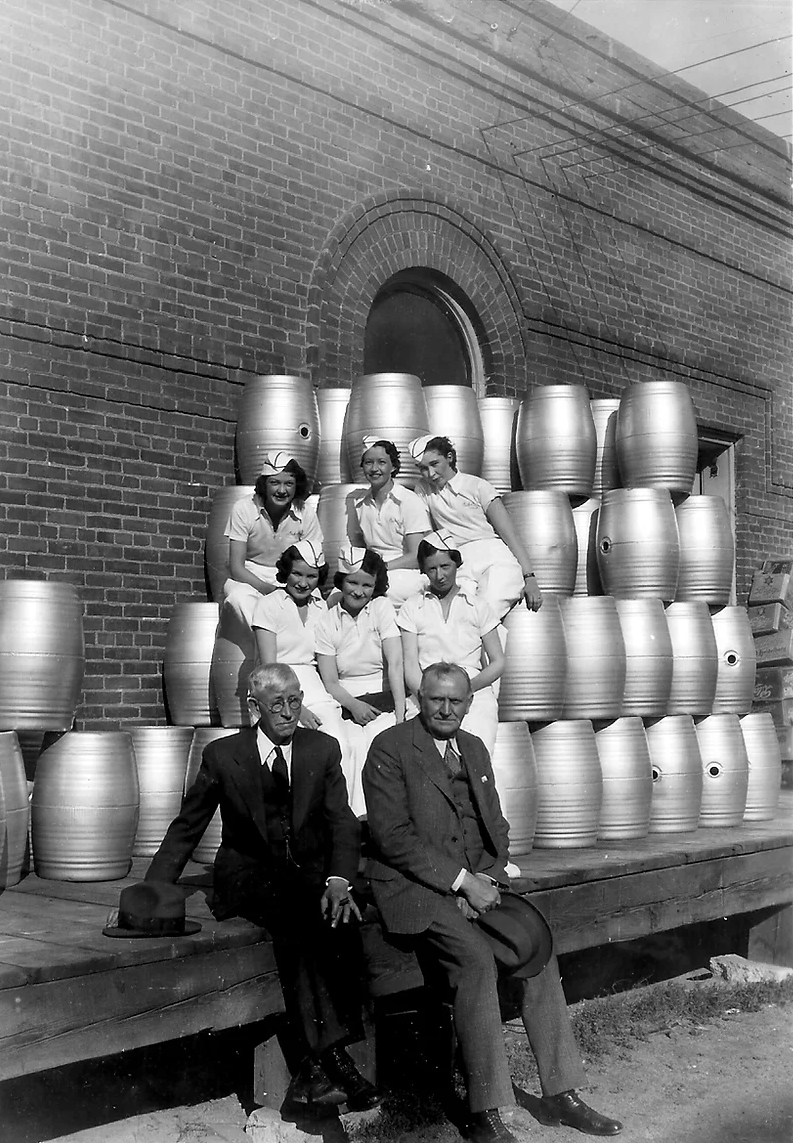
history
Explore the story behind The Brick Office.

the crescent
brewing
company
The Crescent Brewing Company was built in response to a query received by the Nampa Chamber of Commerce in November of 1905. The query asked what the Chamber would do to further the establishment of a brewery costing between $60,000 - $100,000, and in reply, the Chamber made the decision to provide a suitable site. The Chamber deemed the Duffes property as fit, and the dwelling house on the property was moved to the property across the street.
The contractor, Charles P. Stanley, and a crew of 75 constructed the brewery and bottling plant. 1,000,000 bricks were special ordered and laid, and the brewery was so large that the Nampa Leader-Herald termed the project "mammoth". The estimated cost of the building was $130,000.
january 15, 1907
The president of the brewing company, Jacob Lockman, announced a prize of fifty dollars to whomever suggested the best name for it's beer. Fred G Mock won the prize for his suggestion: "Overland". His submission, paired with a story relating to the Overland Trail, was "too tempting for the committee to resist."
may 15, 1907
The Crescent Brewery opened for business! The grand opening event was described by Annie Laurie Bird in her book, My Home Town:
The Columbian Band of Boise played as crowds came and departed. Bountiful tables in the yard were laden with good things to eat and the "Overland" brew. The ladies were entertained in the "beautifully decorated rooms of the handsome house" by Mrs. Lockman, and in the hall a floral piece in the shape of a horseshoe with the company's emblem, the crescent and star, was admired by the hundreds who called.
february 20, 1909
Idaho Governor James H. Brady approved a local option law, prohibiting the sale and consumption of alcohol. Canyon County immediately scheduled a referendum to take place in August, but Nampa was the only place in the county with a majority wet vote.
july 1, 1915
The state legislature passed a prohibition act to go into effect on January 1, 1916. Mr. Lockman, as the head of The Crescent Brewing Company, made plans to convert the brewery into a soft drink manufacturing plant. By July 1, 1915, the machinery was on its way. Once the conversion was complete and the production of soft drinks, cider, and grape juice was underway, the Company was to be known as The Overland Beverage Company.




















December 5, 1933
The Twenty-first Amendment to the Constitution of the United States was ratified, and in anticipation of this event, Jacob Lockman had already made plans to resume operations of The Crescent Brewery. By December 27, brewing machinery from Germany had already arrived and was being installed under the supervision of the master brewer, Charles Inderweis. The malted barley was en route from Manitowoc, Wisconsin, and the hops from Yakima, Washington. The actual brewing of the Overland Beer was slated for the first week of January.
April 17,1934
The Overland Beverage Company celebrated the return of its Overland Beer to market. Jacob and Freida Lockman hosted a beer and sausage lawn party to celebrate the end of prohibition and the completion of the first legal brew of the Overland Beer since prohibition began.
january 1966
The Overland Beverage Company continued operations until shortly after World War II when members of the corporation decided to liquidate the company. Annie Laurie Bird detailed the liquidation sale in her book, My Home Town:
The Charles S. Jacobowitz Company of Buffalo, New York, handled the sale of the machinery, most of which was sent to Bogotá, Colombia, South America. According to Charles E. Volk, who as master brewer and brewing engineer, with Sam Greenberg, had been sent to dismantle the Nampa plant, small brewing companies were no longer able to compete with the large companies; 450 had closed between 1939 and 1953; and this was the thirty-fourth he had helped to dismantle. Enough lumber to build an entire house was used in crating the equipment from the Nampa plant.
To permit a crane to remove the mammoth 14,000-pound copper kettle, handmade and some twelve feet in diameter, from the building to the waiting railroad flat car, a gaping fourteen-foot hole was knocked out of the side of the building. The crane then loaded on other flat cars the ten huge crates of equipment and the five bundles of steel work for their journey to Portland where they would be reloaded to ships of the Grace line to complete their journey to Colombia. A five-ton washer had already been sent to the Dixie Brewery at New Orleans and the barrels, boxes and freezing equipment had been sold locally.
january 1966
The brewery stood empty from 1953 until 1966 when Julius Kleiner, the then-current owner, ordered the brewery to be demolished. The bottling house and the Lockman house still stand to this day.
